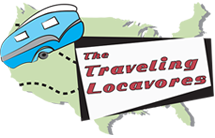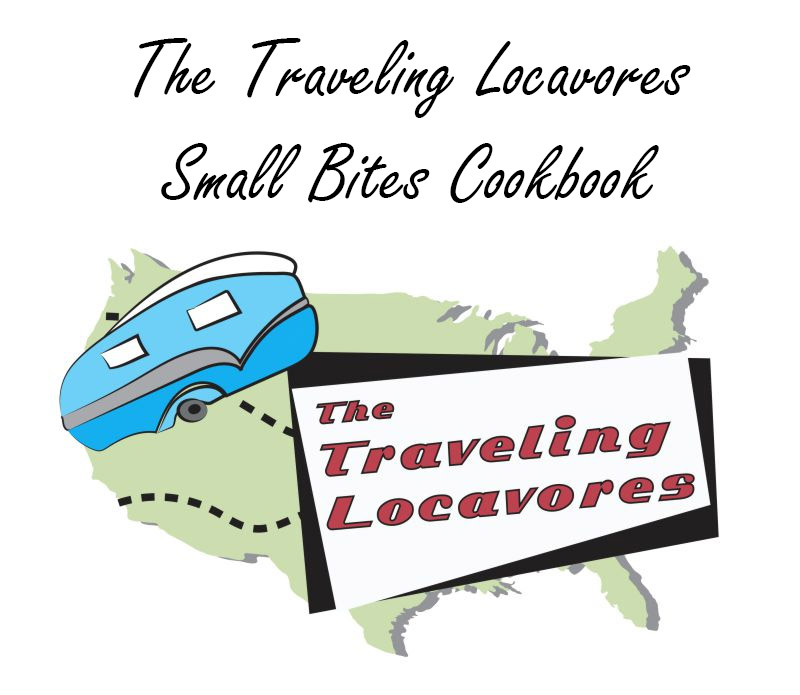For those of you who are new to RVing, I thought it would be helpful for you to have an RV Setup and Teardown Checklist, because it’s so detailed I’ve divided it into Parts 1 and 2. Steve and I know first hand just how important it is to learn proper procedures.

Ladybug all set up at our campsite at John Prince Park Campground in Lake Worth Florida
While we were in New Orleans this winter, we actually saw someone pull out of his campsite, who had forgotten to unhook his electric!!! He was so lucky that no damage was done to his gorgeous big Class A. But that is not always the case.
RV Setup and Teardown Checklist Part 1
An RV setup and teardown is NOT something that you should only do by memory. Often our memories fail us. And even forgetting one little step can lead to disaster. There have been a couple of times, when Steve didn’t use this physical checklist, that he forgot to turn the water on. There was even once recently that he forgot to remove one of our very expensive tire covers. Fortunately he saw it as he was getting into the RV after hooking up the Blue Ox to our Jeep. So please, for your sanity and safety, use these RV Setup and Teardown Checklists.
With some practice and these helpful checklists, you’ll be camping like a pro in no time.
Benefits of an RV Setup and Teardown Checklist
A setup and teardown checklist is so helpful in keeping you organized and ready for adventure at a moment’s notice. Are you looking to get away this weekend? No worries. Packing up quickly to avoid an approaching storm is easy if you have a good checklist.
Checklists are also valuable in helping you keep your camper in great condition, so you don’t get stuck handling unexpected repairs or issues while you’re on the road. If you see anything that’s just not quite right, you should make a note of it so you can check it out the next time you’re able. If only Steve had had our brakes checked as soon as he heard them screeching and grinding, we wouldn’t have needed to be towed to the repair shop for new brakes!
Obviously the setup and teardown steps you take will depend to a certain extent, on which type of camper you have. Motorhome owners wouldn’t need to unhook their trailer, but they would need to unhook the car they’re towing.
Take a gander at the lists and pull out what applies to your particular type of RV and let the camping begin.
Step 1: Assess Your Campsite
When you arrive at your campground you should begin by looking around your campsite before you begin setting up. Be sure to locate the electrical, water, and sewer hookups before you park your RV. This will help you determine exactly where to park based on the length of your water hose, electrical cord, and sewer hose. Make sure to look for potential obstructions, including low-hanging tree limbs and anything that can interfere with your slide-outs being able to extend safely. Assess the grade or slope of your site. First priority should be your sewer connection, since it’s usually your shortest connection.
Then follow the next steps:
Step 2: Parking Your RV
After you’ve determined the ideal spot within your campsite for your camper, it’s time to park your RV. The exact procedure for parking will depend on whether you have a back-in or pull-through site, as well as whether you have a towable or motorized RV. If you are driving a motorhome and are parking in a back-in site, you will need to unhook your tow car first. If you are parking your motorhome in a pull-through site, you have the option of leaving your car hooked up or not.
Once you are parked it’s important to level your RV left to right only first. You should not try to level from front to back at this point because you might need to use stackable or rolling leveling blocks to properly level your camper. You should not underestimate the importance of this step because your refrigerator, slide outs, plumbing and additional components won’t work properly on a tilt!
Next, you should chock the tires on both sides if your camper is a towable trailer. This is a vital safety precaution that insures that your RV won’t move. NEVER UNHITCH A TOWABLE TRAILER OR 5TH WHEEL WITHOUT PROPERLY CHOCKING THE TIRES FIRST. If you’re using the type of chocks that go behind the tires, place them on the front and back tires.

Behind the tire chocks

X-Chocks
There are 2 types of chocks and they can each be purchased by clicking the links for Behind-the-tire chocks which are self explanatory and X-shaped chocks which put pressure between the tires and let you lock down tires that are up on leveling blocks, a situation when normal behind-the-tire chocks wouldn’t work.
Step 3: Unhitching Your Trailer
Now that your rig is parked, it’s time to unhitch your trailer. If you drive a motorized rig, you can skip this step. Unhitching is the process of disconnecting your trailer from your tow vehicle. Before you begin make sure you understand the different parts of your towing gear.

Trailer jack block
To unhitch your trailer, lower your tongue jack. This is where you can either use a big block of wood or a Trailer Jack Block. Next, unhook your chains and breakaway cable. If your rig is equipped with an electric tongue jack you can leave the electrical wire hooked up for now.
Remove the sway bar and the weight distribution bars and just set them somewhere out of your way. Then flip the locking lever and raise the tongue jack off of the tow vehicle’s hitch receiver. Sometimes this may give you a little trouble. If that happens, try to carefully rock the tow vehicle or step on the bumper to give you more leverage.
Next step is to pull your tow vehicle up a few inches. Be sure not to go to far or else you will break the electrical connection.
Then adjust the tongue jack to enable properly leveling your RV from front to back. When this step is completed you can now move your tow vehicle.
Step 4: Stabilize Your RV
The exact method that you use to stabilize your RV will depend on your RV type and stabilizing gear. The main goal is to reduce rocking and bouncing inside the trailer.

Manual scissor jack adaptor

Leveler Jack Pads
Now is the time to lower your stabilizing jacks. If your trailer has manual scissor jacks, you should consider buying a special adapter that would allow you to use your power drill to turn the mechanism. Jack pads would also be beneficial to prevent the stabilizers from sinking on gravel or dirt campsites.
ONCE YOUR JACKS ARE DOWN, DON’T RAISE OR LOWER YOUR TONGUE JACK OR YOU CAN BREAK YOUR STABILIZERS OR TONGUE HITCH!
Step 5: Handle Your Hookups
Once you are parked and your rig is stablized it’s time to hook up your power, water, and sewer connections (depending on what amenities your campsite offers).

Power cord adaptor
Before connecting the electrical cord to the power box, check the amperage that is available at your campsite. You may need to use and adapter if your rig has a 50-amp connection and your site only has a 30-amp outlet. In this case you will need a plug adapter.

RV Surge Protector
It’s important to use a surge protector so plug that in! Surge protectors are expensive but will certainly save you money in the long run. Bad electrical connections can damage your entire system and appliances. Beside to plug in all cables BEFORE turning on the electrical breaker.

Potable Water Hose

In line water filter for RVs
Now you can connect your potable water hose – DO NOT USE A GARDEN HOSE!!! – to the spigot and the hose to your RV;s city water inlet. If you’re using an exterior water filter, attached to your hose.

Water pressure gauge

Y diverter for water hookup
Another important item to connect is a water pressure regulator which will prevent damage to your rig from excessive water pressure. And if you want to access water at the spigot along with the inside your rig, you will need to use a Y-shaped splitter.

Box full of assorted O rings and washers
It’s also a great idea to have some extra washers and O-rings on hand to prevent leaks. Some campground actually have a No Drip policies, so you might need to use those.

RV Sewer Hose

Sewer Hose Support
Finally, use your sewer hose or hoses to connect your tank drain or drains to the campsite’s sewage receptacle. If your site happens to be on a slope, you will need to use a sewer hose support so that your sewer hose is properly angled toward the drain.

Sewer hose elbow fitting

Donut Ring for sewer
I highly recommend that you invest in an elbow fitting and a donut ring so that you can be sure you have a proper seal on your sewer connection. A clear elbow fitting gives you the advantage of being able to keep an eye on things.
Something we have learned in our years on the road is that if you’re staying at your campsite for a few days or more, you might want to open up your gray tank water valve to allow sink and shower water to freely drain out. But it’s also important to note that you should be sure to close this valve before dumping your black tank. That way the gray water can be used to rinse out the sewer hose.
To be sure that you won’t have bad odors in your camper, NEVER leave the black tank valve open. It also helps avoid the dreaded “poop pyramid” that can build up in your black water tank!

Happy Camper black tank toilet treatment
It is very important to use a black tank treatment in any toilets!!! We use Happy Camper to assure that we keep on being happy campers.
Release the black tank valve when your black tank sensor shows you the the tank is full, or when you are leaving the campsite. After the black tank has completely emptied, release the gray water valve. You can finish by running fresh water through the sinks for extra flushing of your water lines and hoses. Then be sure to close both valves when the lines are empty.
Step 6: Finalize Your Setup
Now you are ready for the final steps to setting up your campsite:
Open your slide outs using your power controllers. Check once more for obstacles both inside and outside of your camper.
If you plan to use your awning, put that out. But it’s quite important to note two things. First you need to keep your eye on the weather, because wind and rain can damage your awning. And second, it’s wise to put the awning in when ever you are leaving the campsite unattended. Sudden storms can wreak havoc on awnings. We have seen more than one camper lose their awning in an unexpected storm.
Lastly, set up your campsite with your favorite items like, chairs, tables, outdoor rug, grill, decorative lighting, campfire supplies and so on. Make your campsite cozy and comfortable to make your camping experience as awesome as it can be!
Breaking down your campsite is essentially performing the setup tasks but in reverse. In RV Setup and Teardown Checklist Part 2, which I will publish on Thursday, I will guide you through the process of tearing down and departure.
ARRIVAL AND SETUP CHECKLIST
Exterior
Check level
If needed, level side to side
Chock your tires
Place support blocks under the stabilizing jack
Unhitch your trailer
Level your trailer front to back either manually or with an electronic leveling system
Connect surge protector and power cord
Connect water regulator and potable water hose as well as Y and garden hose (optional)
Connect sewer hose if campsite has sewer available
Put out your awning and outdoor furnishings
Interior
Extend any slide-outs
Turn on the refrigerator or switch the power source
Turn on the propane
Turn on the heat/air if needed
Light pilot for the oven
Turn on the water heater
Unpack secured items
Set up your furniture if needed
Disclaimer: This post includes affiliate links, and I will earn a commission if you purchase through these links. Please note that I’ve linked to these products purely because I recommend them from first hand use and they are from companies I trust. There is no extra cost to you when you purchase through my links.
These checklists were inspired by and article from Campendium.com.









